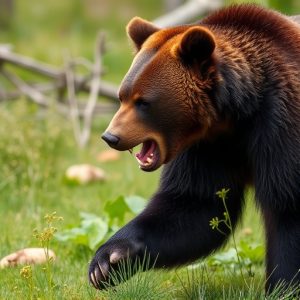Mastering Bear Spray Usage: When It’s Effective Against Charging Bears
Understanding bear behavior is key to effective use of bear spray in close encounters. Maintain dist…….
Understanding bear behavior is key to effective use of bear spray in close encounters. Maintain distance, make noise, and aim directly into a charging bear's face with OC or almond oil-based spray. Prioritize prevention through awareness and noise-making, as spray assists escape not absolute protection. Bear spray should be used within 20-30 feet, aiming at eyes and nose for temporary disorientation.
“Bearing the brunt of a charging bear can be a terrifying scenario for any outdoors enthusiast. While bear spray is often touted as a reliable defense, understanding its effectiveness under various conditions is crucial for safety in bear country. This article delves into the science behind bear behavior and offers practical guidance on when and how to use bear spray properly. We explore common misconceptions, different types of spray, and step-by-step usage tips to ensure you’re prepared for potential encounters.”
- Understanding Bear Behavior and When Spray Might Not Help
- Effective Usage of Bear Spray: Steps to Follow
- Types of Bear Spray and Their Efficacy
- Common Misconceptions About Bear Spray and Charging Bears
Understanding Bear Behavior and When Spray Might Not Help
Understanding bear behavior is key to knowing when bear spray might not be effective. Bears, especially grizzly bears, are unpredictable and can charge at high speeds—up to 30 miles per hour. They primarily use their sense of smell and hearing to detect potential threats, making noise and odour control crucial in deterring them. Bear spray is designed to irritate the eyes, nose, and respiratory system, creating enough disorientation for a bear to flee. However, it’s essential to understand that bear spray isn’t always a foolproof solution. In dense forests or areas with poor visibility, bears may not detect the scent of the spray, especially if they are focused on finding food. Additionally, if a mother bear feels her cubs are threatened, she might become more aggressive regardless of any perceived irritants.
When considering when to use bear spray properly, it’s crucial to maintain a safe distance and make loud noises to startle bears before deploying the spray. If a bear is already charging or within striking distance, spray directly into its face while backing away. Keep in mind that bear spray is most effective as a deterrent when used correctly—as a last resort when all other escape routes are blocked and a confrontation seems inevitable.
Effective Usage of Bear Spray: Steps to Follow
When to Use Bear Spray Properly: Steps to Follow
Bear spray is an effective deterrent against charging bears, but its success depends on proper usage. Always carry bear spray when hiking or camping in bear country, and ensure it’s easily accessible. Before encountering a bear, assess the situation: if you see a bear but it hasn’t noticed you yet, use this opportunity to retreat slowly and quietly. If the bear does notice you and begins to charge, prepare your spray. Hold the canister upright, aim slightly below the bear’s chest, and pump the nozzle while moving backward at a steady pace.
The key is to create a barrier of spray between you and the bear, disrupting its forward motion and giving you time to escape. Maintain eye contact with the bear until it turns away or retreats. It’s crucial to practice using bear spray before venturing into potential bear encounters; familiarize yourself with the nozzle’s range and the spray pattern for optimal effectiveness. Remember, bear spray is a tool to deter and escape, not a guarantee of safety. Always prioritize prevention through noise making, staying aware, and following local guidelines for bear country safety.
Types of Bear Spray and Their Efficacy
When it comes to protecting yourself against charging bears, bear spray is a popular and effective option. There are primarily two types available: oleoresin capsicum (OC) and almond oil-based sprays. OC spray is derived from chili peppers and is known for its high concentration of capsaicin, the active ingredient that causes a burning sensation in the eyes and respiratory system of bears. This type is generally considered more potent and effective against aggressive bears. Almond oil-based sprays, on the other hand, are often preferred by those who experience respiratory issues due to their gentler formula.
The efficacy of bear spray depends on proper usage. It’s crucial to spray directly into the bear’s face, eyes, and nose when it charges. The close proximity and direct application ensure the capsaicin irritants reach the bear’s sensitive areas, temporarily disorienting and slowing it down. However, factors like wind direction, distance, and the bear’s behavior can impact the spray’s effectiveness. Therefore, using bear spray should be a last resort when other prevention methods, such as making noise to deter bears, are not successful.
Common Misconceptions About Bear Spray and Charging Bears
Many outdoor enthusiasts and adventurers in bear country hold misconceptions about bear spray and its effectiveness against charging bears. A common belief is that bear spray can stop a bear in its tracks from any distance, but this isn’t entirely true. Bear spray is most effective when used properly in close proximity to an approaching bear—typically within 20-30 feet (6-9 meters). It works by irritating the bear’s eyes and nose, temporarily disorienting it, which can give you valuable time to escape or defend yourself.
Another misconception is that spraying from a distance ensures your safety. While a bear spray can deter a curious or defensive bear, it may not stop an aggressive or charged bear. The spray’s effectiveness decreases significantly as the distance between you and the bear increases. It’s crucial to remember that bear spray is a tool for escape and defense, not a foolproof protection against all bear encounters. When in bear country, always maintain awareness, make noise to avoid surprising bears, and carry bear spray as a last line of defense, knowing how and when to use it properly.
Bear spray can be an effective tool for deterring charging bears, but it’s crucial to understand its limitations. While it’s most useful in close-range encounters, proper usage and choosing the right type are essential. Remember, bear spray is not a guarantee of safety, especially when bears are desperate or protecting their young. Always carry it responsibly, follow application instructions, and be prepared to take evasive action even if you use it. Understanding bear behavior and knowing When to Use Bear Spray Properly can significantly enhance your safety in bear country.


